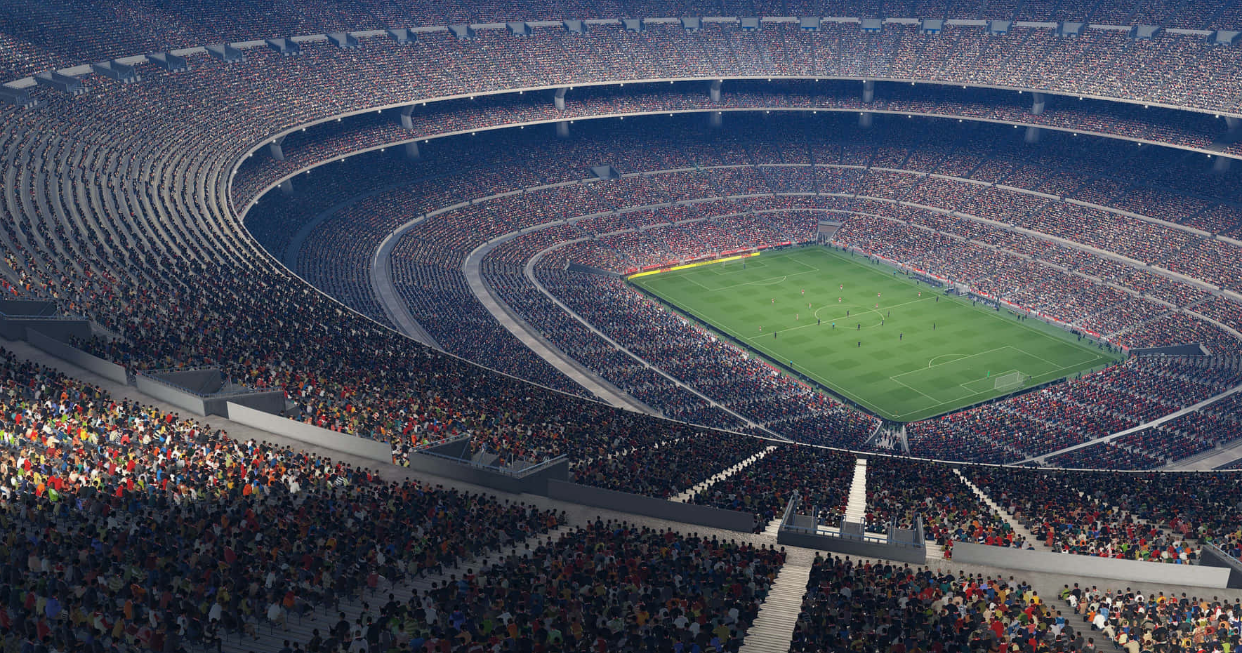A pro soccer field is around 100-130 yards long and 50-100 yards wide. The exact size may vary depending on the league, but FIFA regulations state the length should be between 100-130 yards and the width between 50-100 yards. The field is divided into two halves with a center circle and surrounded by touchlines and goal lines with goals placed in the center of each goal line. The playing surface can be natural grass or artificial turf. Soccer fields are larger than football fields, which are typically 100 yards long and 53.
3 yards wide. We will delve deeper into the dimensions and rules of a pro soccer field and explore how they compare to other sports fields.
How big is a pro soccer field

History of Soccer Field Dimensions
Discover the history of soccer field dimensions and explore how the size of professional soccer fields has evolved.
Evolution of Soccer Field Size- How big is a pro soccer field
Originally, soccer fields varied in size, but standardization began in the late 19th century. The FIFA regulations later set the official dimensions to 100-110 meters in length and 64-75 meters in width. This standardization ensured uniformity across professional soccer fields worldwide.
Impact of Regulations on Field Size
Regulations not only dictate the dimensions but also influence gameplay. A larger field enhances strategy and ball movement, while a smaller field encourages quicker plays. These regulations have a significant impact on player performance and team tactics.
International Standards
How Big is a Pro Soccer Field and International Standards: Soccer, known as football in many countries, is the most popular sport worldwide. Understanding the dimensions of a professional soccer field is essential for players, coaches, and fans. International standards set by FIFA and UEFA ensure that soccer fields adhere to specific regulations and requirements, providing a uniform playing environment.
Fifa Regulations
FIFA, the international governing body of soccer, has established specific regulations for the dimensions of a professional soccer field. According to FIFA regulations, the length of the soccer field must be between 100 meters (110 yards) and 110 meters (120 yards), while the width should be between 64 meters (70 yards) and 75 meters (80 yards). The field is divided into two halves by the halfway line, and a center circle with a radius of 9.15 meters (10 yards) is marked at the midpoint of the halfway line. Additionally, the penalty area, also known as the 18-yard box, extends 16.5 meters (18 yards) from each goal post and 16.5 meters (18 yards) into the field.
Uefa Field Size Requirements
UEFA, the governing body for European football, has specific field size requirements that align with FIFA regulations. According to UEFA, the length of the soccer field should be between 100 meters (110 yards) and 110 meters (120 yards), and the width should be between 64 meters (70 yards) and 75 meters (80 yards), in line with FIFA standards. These dimensions ensure consistency across professional soccer fields in UEFA-affiliated competitions, maintaining a standard playing environment for teams and players.
Variations In Field Sizes
When it comes to the size of a professional soccer field and variations in field sizes, it’s essential to understand the differences that exist across different levels of play, from professional leagues to youth soccer fields. The dimensions of a soccer field can vary, and it’s important to be aware of these variations to appreciate the game fully.
Professional Leagues
In professional soccer leagues such as the English Premier League and La Liga, the standard dimensions of a soccer field range between 100-130 yards in length and 50-100 yards in width. These variations in size can impact the style of play and strategy adopted by teams, with larger fields often favoring possession-based teams and smaller fields suiting more direct styles of play.

Youth Soccer Fields
For youth soccer fields, the size of the field can vary based on the age group of the players. Generally, the dimensions of a youth soccer field are smaller than those of professional leagues. For instance, for players under the age of 12, the field may measure approximately 70-80 yards in length and 40-60 yards in width. These smaller field sizes are designed to accommodate the physical capabilities and skill level of younger players, promoting a more enjoyable and developmentally appropriate playing experience.
Key Components of A Soccer Field
Have you ever wondered how big a professional soccer field is and what are its key components? Let’s explore the dimensions of field lines and goal size and placement in detail.
Dimensions of Field Lines
The standard dimensions of a soccer field include a length between 100 to 130 yards and a width between 50 to 100 yards. The center circle has a radius of 10 yards, and the penalty area is typically 18 yards from the goal line.
Goal Size And Placement
A soccer goal is 8 feet high and 8 yards wide. It is centrally positioned on the goal line, with the crossbar at a height of 8 feet from the ground. The goal area extends 6 yards from each goal post and 6 yards into the field.
Influence on Game Strategy
When it comes to soccer, the size of the field plays a crucial role in shaping the game’s strategy and tactics. Understanding the influence of field dimensions on the game can provide valuable insights into how teams approach their gameplay.
Effect of Field Size on Tactics
The dimensions of the soccer field directly impact the tactics employed by teams. A larger field allows for more space, enabling teams to spread out and utilize width. On the other hand, a smaller field encourages a more compact style of play, emphasizing quick passing and close ball control. These variations in field size can significantly alter the tactical approach of teams during a match.
Home Field Advantage
Home-field advantage in soccer is closely linked to the familiarity and comfort that a team has with the dimensions of their home field. Teams tend to adapt their playing style to suit the specific dimensions of their home field, leveraging their knowledge of the terrain to gain an edge over visiting teams. This advantage can influence the outcome of matches and is a key consideration in soccer strategy.
Technological Innovations In Field Measurement
When it comes to the size of a professional soccer field, the accuracy of measurements is crucial for maintaining the standards of the game. Technological innovations in field measurement have revolutionized the way soccer fields are designed and maintained, ensuring optimal performance and accuracy.
Use of GPS Tracking
The use of GPS tracking technology has significantly enhanced the precision and efficiency of measuring soccer fields. GPS devices are employed to capture accurate field dimensions, ensuring that the playing surface meets the required standards set by regulatory bodies. This technology allows for real-time data collection, enabling groundskeepers to monitor and adjust field measurements as needed to maintain the integrity of the playing surface.
Data Analysis For Optimal Performance
Data analysis plays a critical role in ensuring the optimal performance of soccer fields. By analyzing the gathered data, groundskeepers can identify areas that require attention, such as irregularities in the field surface or variations in dimensions. This enables them to implement targeted maintenance and adjustments to uphold the quality and consistency of the playing field, ultimately benefiting the players and the game itself.
Environmental Factors Impacting Field Dimensions
Pro Soccer Fields come in various sizes, influenced by Environmental Factors such as Weather Conditions and Maintenance Challenges.
Weather Conditions
Weather conditions can affect the dimensions of a soccer field, especially in regions prone to extreme weather patterns. Rainfall can lead to pitch waterlogging, impacting playability and field size. In contrast, high temperatures may require adjustments to prevent heat stress on players.
Maintenance Challenges
Maintenance challenges play a crucial role in determining the size of a soccer field. Regular mowing and fertilization are essential to keep the pitch in optimal condition. Drainage systems must be well-maintained to prevent water accumulation, ensuring a consistent playing surface.
Future Trends In Soccer Field Design
How Big is a Pro Soccer Field and Future Trends in Soccer Field Design
Adaptations For Climate Change
With the increasing impact of climate change, soccer field design is evolving to incorporate sustainable materials and irrigation systems that reduce water consumption. Artificial turf with enhanced durability and resilience to extreme weather conditions is also being developed to ensure consistent playability. Additionally, stadium infrastructure is being designed to withstand natural disasters such as floods and hurricanes, ensuring the safety of players and spectators.

Integration of Virtual Reality
The integration of virtual reality technology in soccer field design is revolutionizing training methods and fan experiences. Virtual reality simulations allow players to practice in different environments and scenarios, enhancing their skills and decision-making abilities. Furthermore, virtual reality experiences for fans provide an immersive and interactive way to engage with matches, creating new opportunities for sponsorship and revenue generation for clubs and leagues.
Conclusion
The size of a professional soccer field is standardized worldwide, providing a vast playing area for athletes. Understanding these dimensions is essential for players, coaches, and fans to appreciate the scale of the game. Whether watching or playing, the field’s size adds to the excitement of soccer.

